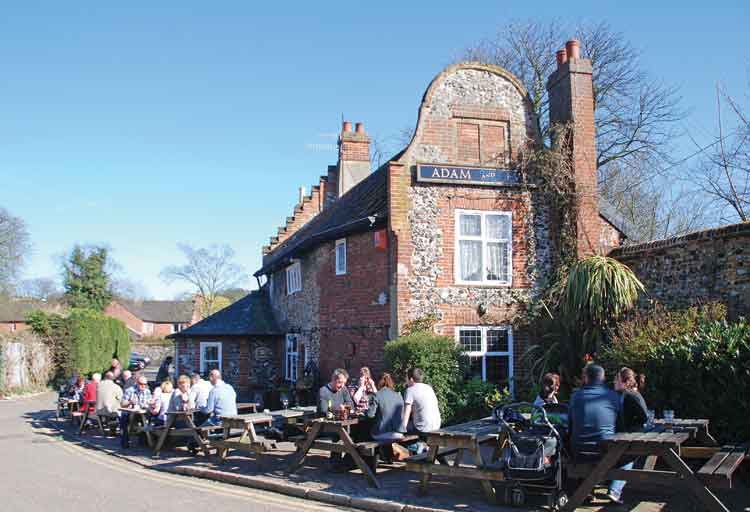Norwich pubs of yesterday - pass curser over thumbnails for more information

Backs, Gentleman's Walk
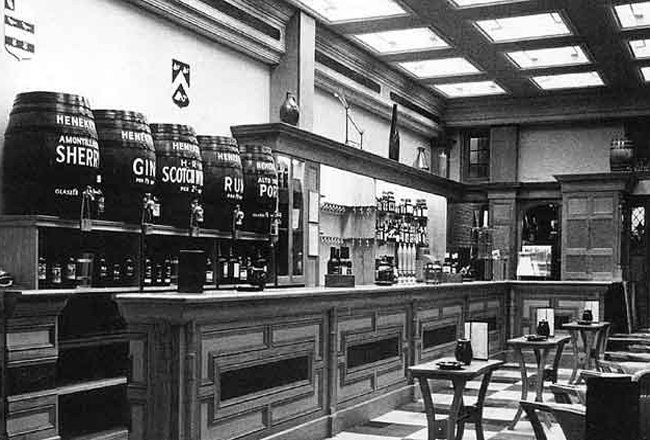
By the 1840s the Backs family owned the 15th century Curat House on the Haymarket. They were known as being the leading vintners in the City. This activity was facilitated by the huge labyrinth of cellars beneath the house where the firm did their own bottling. In 1952 the Back family sold out to Hennekeys who owned the premises until its closure in 1971. In 1925 Walter Wicks reports: ‘Upon entering, one feels suddenly transported from the bustle and din of a sternly commercial age to the rollicking days of Falstaff and the merrie England of Good Queen Bess.’
Bram Lowe remembers visiting in the early 1960s: ‘The only time you saw ladies was in the Elizabethan Bar, which was presided over by a lovely old gent called Alfred Parsons who was your classic aged retainer. He’d prepare hot toddies in a brightly burnished kettle on the bar which he’d religiously boil and bring over to your table to serve.’
In the 1960s the house catered for a wide range of clientele. However, towards the end of its life it became the favourite meeting place for students from the ‘new’ university, who eventually took it over. Unfortunately the students did not possess the spending powers to support a bar of this size. Takings declined and in the autumn of 1970 the management took the unprecedented step of banning students. This was followed by a series of series of protests culminating in a student sit-in. The following year in May 1971 Back’s closed an event described by John Riddington Young as ‘one of the greatest single losses to the Norwich drinker’.

Boar's Head, Surrey Street
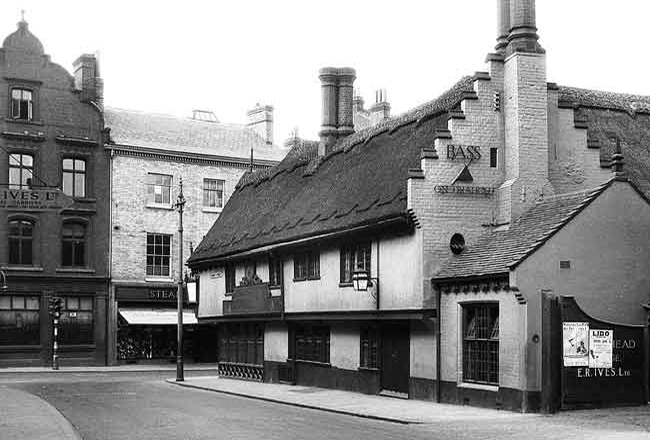
The Boar’s Head (Surrey Street) was housed in a 15th century building. Originally called the Greyhound, by 1840 the premises together with its adjoining property and yard had been purchased by the Norgate family whose coat of arms incorporated a boar’s head, hence the change of name.
In the mid 19th century landlord Fred Philips tastefully fitted out a room capable of seating 200 visitors, which he called ‘The Shades’, in an attempt to introduce Norwich citizens to the delights of the Music Hall.
In 1902 Arthur Turner was appointed as Norwich City Football Club’s secretary. Arthur was the manager of the Boar’s Head from 1908 to 1916 so the hostelry naturally became the headquarters of City’s first Supporter’s Club, where they met until the club outgrew the venue.
The Boar’s Head was badly damaged in the Baedeker Raids of April 1942. It was subsequently rebuilt eventually reopening in 1952/3. Subsequently in 1966 it was given a ‘Flemmish’ makeover complete with a huge Flanders’ tapestry and a Windmill Salon which incorporated a model Dutch windmill. Not surprisingly the look doesn’t appear to have caught on and in 1972 all these decorations were removed. The premises were subsequently converted into a large dimly lit room with no windows and it was reinvented as a music pub with a dais built at one end for pop groups and a large dancing area. Sadly this venture was unsuccessful and the Boar’s Head eventually closed its doors in the autumn of 1974.

Dukes Palace Inn, Duke Street
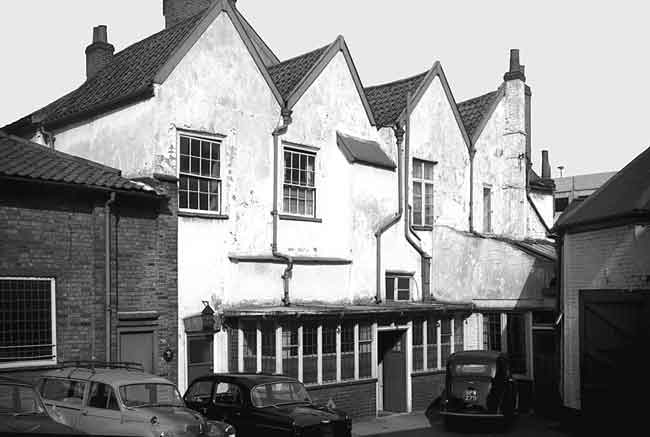
Located on Duke Street the inn was originally part of the home of the Duke’s of Norfolk who first settled here during the reign of Henry VIII. In 1602 the original house was pulled down and work was started on a magnificent new building which was even used to entertain royalty when Charles II visited the City in 1671.
However, all the jollifications came to an end in 1708 when the Duke fell out with the Mayor leading to him taking the rather extreme action of pulling down part of his Palace and quitting the City. Subsequntly part of the Palace became a workhouse, the inmates living in somewhat different conditions from its previous inhabitants, and the Duke’s Palace Inn was established there. It is unclear when it started trading, however, on December 14th 1745 the Norwich Mercury announced the departure of the Christmas Coach for London from here. It was obviously a well endowed establishment able to furnish gentlefolk with ‘a landau, a handsome glass coach, chaise and chariot, mourning coach and horse…to any part of England’.
In 1803 the Inn played host to Mr Polito’s Wild Beast Show when the exhibition included: ‘a royal lion, a striped Bengal tiger, a beautiful leopard, a laughing hyena and a ravenous wolf.’ Whilst in 1855 the Inn hosted a grand dinner to celebrate the abolition of tolls on the nearby Duke’s Palace Bridge
Sadly the buildings were demolished in the 1960s to make way for St Andrew’s car park.

Ferry Boat, King Street
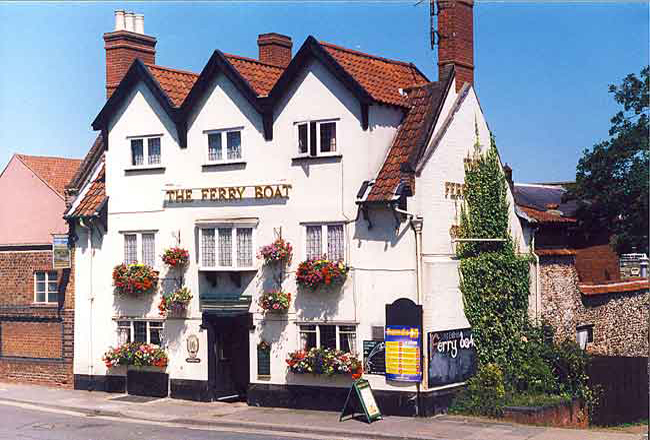
The Ferry Boat Inn on King Street was licensed as far back as the 1820s when it was known as the Steam Packet, a steam packet being ‘a ship that sails a regular route between two ports’. In the late 1800s such a steam ship travelled from Norwich to Bramerton Woods End, Coldham Hall and other riverside resorts. It was in 1925 that it was it was rechristened, its new name name deriving from the activity of a former landlord, William Thompson, who set up a ferry service across the Wensum. The pub was memorable in the early 1970's for having well worn seats in the front bar which were the same shape and had the same covering as then used by the Eastern Counties Omnibus Company! At this time the landlady was Mrs ‘Mottie’ Warminger, who ran the house for 30 years from 1945. She was considered by John Riddington Young as being a real character who presided over the bar ‘with queenly grace at the ripe old age of 84’ she was much ‘cherished’ and missed after her death after which the pub was closed for a short period. It reopened as a freehouse and regulars found that a stuffed cat had been introduced to guard the chimney breast. In 2006 the Ferry Boat was ‘closed for refurbishments’ and was never reopened.

Horse Barracks, Barrack Street
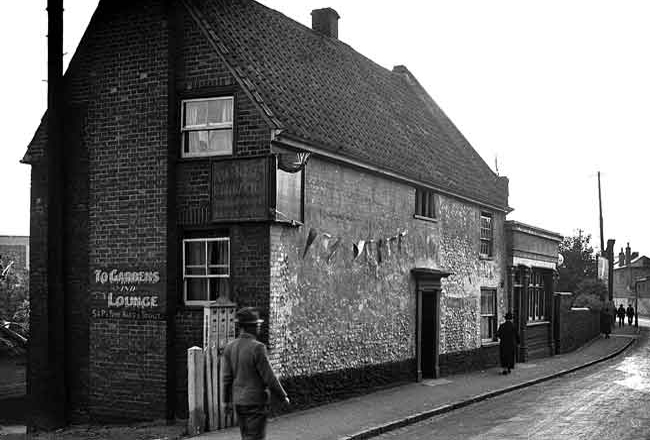
Located at 173, Barrack Street the licence to the inn can be traced back to 1822. The name reflects its proximity to the Cavalry Barracks.
It is reported that a sergeant who returned from the Boer War brought a baboon home from Africa with him. When he became landlord of the inn he kept it up a tree in front of his pub. Unfortunately his scheme misfired when the animal went mad and a cavalry officer had to be sent across from the barracks to shoot it!
The original house was demolished in the 1930s as part of a road widening scheme and rebuilt c1938 but was partly destroyed during an air raid on April 29th, 1942. Undeterred it reopened in January the following year in a temporary building.
In the 1960s Les Eyre, an inside left for NCFC from 1946 to 1951, was the landlord. Around the same time it was the ‘home’ of local pop group Malcolm and the Toffs.
It continued to trade as the Horse Barracks until 1975 when it was renamed the John W.Stokes. It closed in 1989 and demolished in 2002.

Jolly Butchers, Ber Street
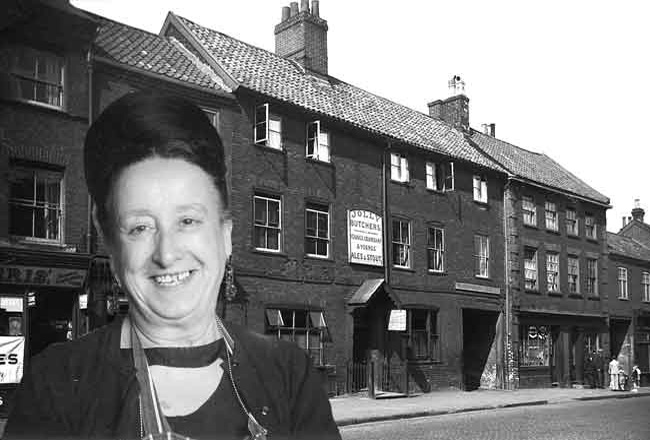
The licence of the Jolly Butchers (Ber Street) can be traced back to the early 19th century. During the WWI it was kept by a William Day, who had been head cellarman for Morgans. William’s son, Corporal Sidney Day, won the Victoria Cross for heroic action in WWI. It was in 1935 that landlady Antoinette Hannent (nee Carrara) took over the helm of the pub and steered it on to become part of Norwich folklore. Antoinette, better known as Black Anna, because of the colour she habitually wore, was a consummate performer particularly renowned for singing jazz numbers with double entendre. During WWII she was exceptionally popular with US airman who admired her talent and enthusiasm. After the war locals flocked to the Jolly Butchers to hear her, and others, perform. She will ever be associated with the pub where she reigned supreme for over 40 years. Out at the back of the pub was a long brick building believed to have been built around 1850 specifically as a lodging house. By the 1920s it was known as Day’s lodging house after William Day (see above). The ground floor contained one huge, tiled kitchen with a big cooking range that used to be kept alive both day and night. Upstairs were dormitories. It was rumoured that at one time the Jolly Butchers had 76 beds. By Anna’s time it was basically a doss house. The pub itself was made up of a lounge and bar separate by a narrow hall way. Neither room was more than twelve by fifteen feet. It could get really smoky and hot in the main bar, where entertainment took place, so on busy nights Anna took the doors off the hinges to let the smoke out and also to let people in the passageway hear. The Jolly Butchers closed after Anna’s death in 1976.

King's Head, Gentleman's Walk
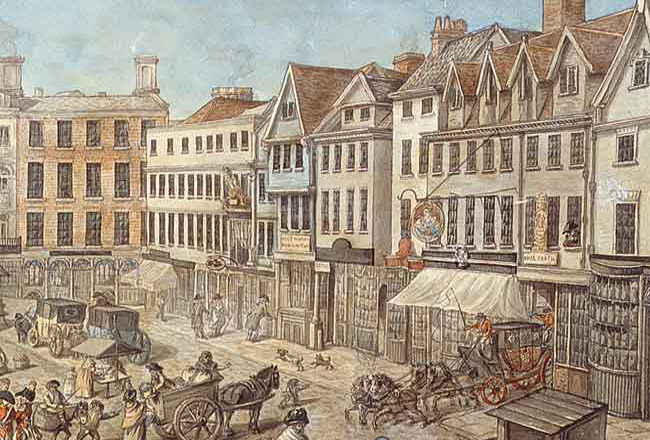
The King’s Head was originally located on the Market Place. It was a popular coaching inn particular favoured by Parson Woodforde, the Rector of Weston Longville, who often stayed here and featured it in his ‘Diary of a Country Parson’. It was also famed for offering outstanding entertainment, including prize fights, plays and natural curiosities. Thus it was here in 1797 that the major attraction was the ‘greatest’ man in the world, namely the Irish giant with the stage name O’Brien (real name Patrick Cotter) who was eight feet four inches tall (his skeleton is preserved in the museum of the Royal College of Surgeons in London). In 1807, 200 spectators witnessed a prize fight between the two noted pugilists of the day, Tom Cribb and John Gulley. It all goes to make today’s pub entertainments a little tame!
During this time the Norwich Mail Coach Office was located at the Kings Head.. In 1802 two mail coaches travelled from here to London daily, one running via Ipswich the other via Newmarket.
In 1813 the building was destroyed to make way for Davey Place. At the time Baptist radical, Alderman Davey, found it amusing to announce that he would ‘blow a hole in the king’s head’, which resulted in his house being put under guard. Thus proving that it is not a good idea to crack political jokes when there is danger of revolution! The license was transferred to Castle Street were the King’s Head continued trading through to 1981 after which the building became the home of the Body Shop.

Magpie, Magpie Street

The origins of the Magpie Tavern can be traced back to 1806.
At one time an antiquated weighing machine was attached to the front of the house, it had a large beam from which huge chains hung down. It was used to weigh wagons and their merchandise before they entered the City through Magdalen Gate. Locals nicknamed the Magpie the ‘Weighing Chains’.
There used to be four ‘Magpies’ in Norwich, it is thought that the name could be a corruption of Magotty Pie remembered from the nursery rhyme : ‘Round about, round about, Magggoty Pie.My father loves good ale, and so do I.’
In 1975 John Riddington Young described the Magpie as ‘a very warm hearted little beer parlour with its cosy carpeted public bar and brightly painted Britannia tables…(and a) fine Edwardian dresser.’ Although it survived into the twenty first century it is now closed.

Old Barge, (Dragon Hall) King Street
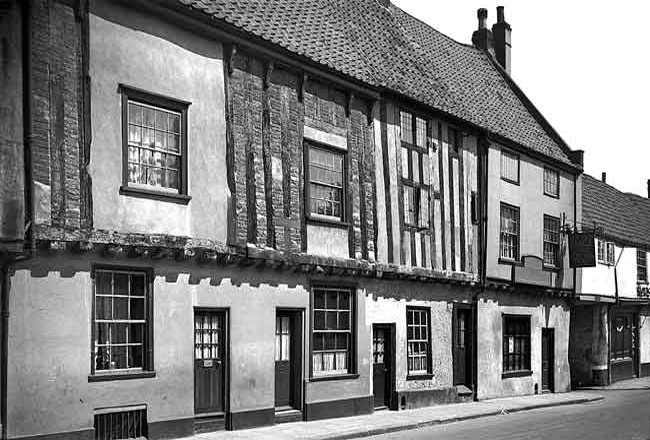
The Old Barge Inn, called the Two Jolly Wherrymen in the 18th century, owes its name to the proximity of the River Wensum. It in turn gave its name to the yard that is located behind, which in the 19th century was filled with low quality housing.
Inhabitants of Old Barge Yard included cowmen, who grazed cattle over the river, and brewery workers. The yard and their buildings were demolished in 1937 as part of the city council’s slum clearance programme. Only one cottage remains.
Although damaged in enemy action in 1942 this was not serious and in 1948 Fred Hall, Norwich City player, began a three year stint as landlord. Fred was City’s goalkeeper in the 1930s and throughout the war.
In 1969 Watney Mann closed the pub and continued to use it as a training centre.
The Old Barge was part of the medieval building known as Dragon Hall. In 1979 Norwich City Council bought the Old Barge, together with its neighbours, which enabled essential repair works to be completed. Following an extensive renovation the Dragon Hall has been returned to its former medieval glory and is acknowledged to be one of the most important historic buildings in Norfolk.

Orford Arms, Red Lion Street
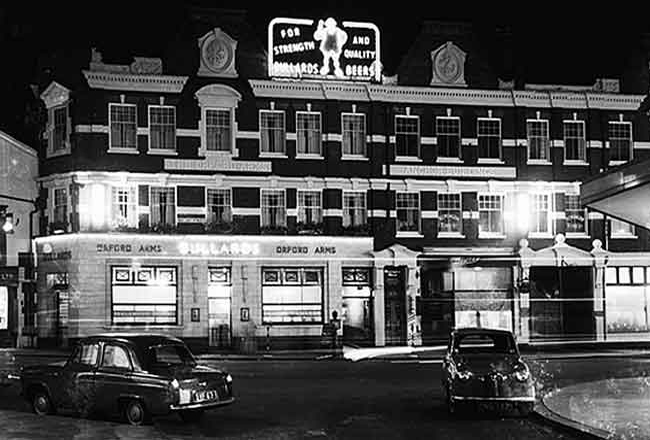
The licence of the Orford Arms (Red Lion Street) can be traced back to 1865
It was in 1962 Douro Potter and his family returned to Norwich from Leicester and took over the lease of the Orford Arms. Douro allowed local agents to book acts for the Cellar (a room located under the main pub) although he remained responsible for its bar. It was this decision which gave the premises a cult status and ensures that those who visited the Orford in the heady days of the 1960s still remember it today. At its peak the Cellar had the atmosphere of the famous Cavern Club in Liverpool. Its maximum capacity was 300 yet incredibly it played host to performers who became international stars such as: Eric Clapton, Rod Stewart, Ginger Baker and Gino Washington. Additionally many local groups performed here including; The Continentals, Lucas & the Emperors and Gary Freeman & the Contours.
Harvey Platt remembers visiting the Orford Arms in the 1960s: ‘It had three bars on the ground floor. One was known as the Big Room which, on the back of the popularity of the Orford Cellar, became an entertainment venue in its own right. It had fluorescent lights picking up the vivid DayGlo wall coverings which included a big picture of Al Capone and an extensive juke box’
By the end of the 1960s the Orford’s popularity was waning. Around 1967/8 many had turned their backs on the traditional Rock & Roll and Rhythm & Blues bands which had made the Cellar such a popular venue. For the vast majority seeing a band was no longer the most important part of a night out. In fact listening to records became a more popular form of entertainment. In 1970 the Potters gave up the tenancy of the Orford Arms and the venue was subsequently closed in 1974. Today a building society occupies the premises.

Rifleman, Crossover Street
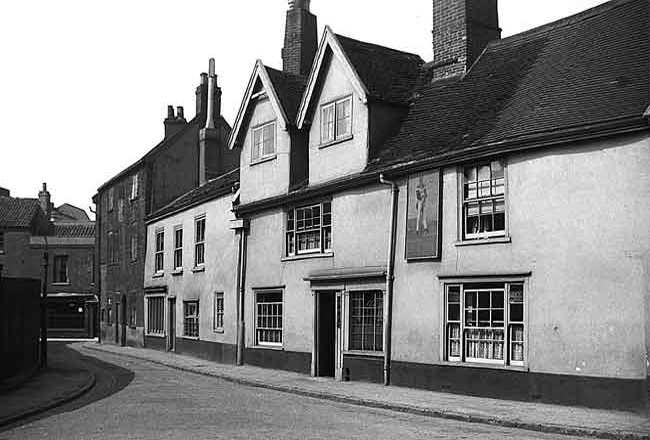
Built in 1626 the Rifleman was well known for being John Crome’s (1760 to 1821) local. It is said that the artist would be found nightly in the snug.
In 1826 the rather unusually named Dirty Shirt Club was founded at the Rifleman. It originated when a local master weaver paid his men here and they stayed on to gossip and drink. The name originated from the fact that they still wore their working clothes. Each member had his own churchwarden pipe with his initials inscribed upon the bowl which would be given to him when he entered. New members had the honour of smoking from a silver pipe.

Royal Hotel, Gentleman's Walk
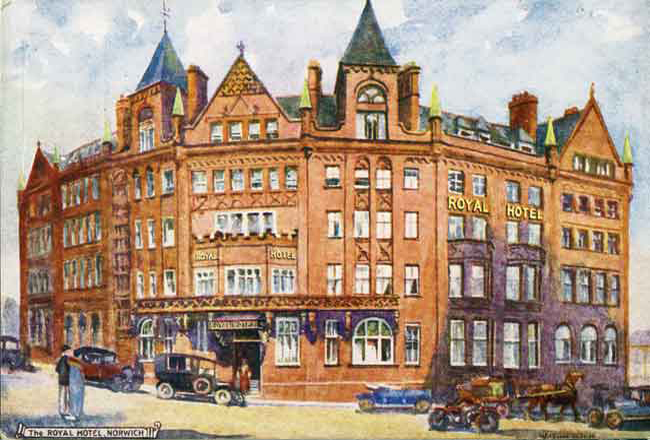
The Royal Hotel was situated on Gentleman’s Walk where it was first licensed c1840. It was located on the site of the Angel which is known to date from the 15th century. The Angel was a coaching inn which provided a range of shows to entertain its guests these included a visit by a pair of elephants in 1685, followed by a series of ‘monsters freaks and marvels’!
It was on July 18th 1840 the demise of this colourful establishment was announced in the Norfolk Chronicle when it was reported ‘The public are respectfully informed that the Angel Inn, Market Place, Norwich, having recently been disposed of, is now refurnishing and fitting up with every convenience for the reception of families and commercial gentlemen, and will in future be know as the Royal Hotel.’
Following the refurbishment it became one of Norwich’s principal hostelries and was the venue for many sumptuous parties. Even when it was only six months old it was the venue for a banquet given by the Mayor to celebrate the christening of the Princess Royal. 16 years later it hosted the celebrations for her wedding. Despite its early popularity c1897 it moved to a new venue on Bank Plain and the hotel was converted into the beautiful Royal Arcade.
In the 1880s there were over 450 pubs within Norwich’s city walls. Many would have been tiny alehouses occupying little more than the downstairs room of a house. Since this time a combination of legislation, war time raids and changes in culture have led to many closing.
Although many have gone, they have not been forgotten and still contribute to the City’s folklore. Today many still remember watching Black Anna perform at the Jolly Butchers or listening to the Continentals at the Orford Cellar.
In this section we recall a selection of the City’s favourites.
